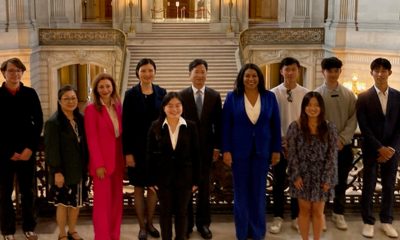Technology
Official Says China May Raise Damages Caps for IP Violations
ERIKA KINETZ, Associated Press
SHANGHAI (AP) — China is considering raising its notoriously low limits on damages for intellectual property violations and strengthening litigation on trade secret theft, a Shanghai city official said Tuesday.
The comments by Lyu Guoqiang, commissioner of Shanghai’s Intellectual Property Office, echo an action plan issued in December by the State Council, China’s top administrative authority, which called for “increasing the application of criminal fines” as part of an effort to enhance criminal enforcement and judicial protection for intellectual property.
Taken together, the moves suggest a deepening commitment to IP enforcement in China, which is trying to wean its economy from low-end manufacturing and seek growth from innovation instead.
“Enhancing intellectual property protection is out of the intrinsic need of China’s economic development and economic transformation,” Lyu said.
Patent awards are currently capped at 1 million yuan ($160,905), trademark violations at 3 million yuan and copyright violations at 500,000 yuan — fractions of the potential compensation offered in U.S. courts. Those low levels and a general lack of faith in China’s legal system have pushed some brands to seek redress using courts outside of China.
“Many rights holders complain the damages are too low,” Lyu said. “China is not America. Our economies are different, but we still need to consider adjusting the damages standards.”
He said the government also was considering allowing brands to pursue punitive damages, as is done in many Western countries, and make it possible to get injunctions issued earlier in cases alleging theft of trade secrets.
“They want to learn from other systems,” said Michael Mangelson, the intellectual property attache at the U.S. Consulate in Shanghai. “They believe the U.S. has a system in place that facilitates innovation. That’s the focus for China now.”
Copyright 2015 The Associated Press. All rights reserved. This material may not be published, broadcast, rewritten or redistributed.
Community
Advanced Conductors Provide Path for Grid Expansion
Utility companies in the United States could double electric transmission capacity by 2035 by replacing existing transmission lines with those made from advanced materials, according to a new study published Monday in the Proceedings of the National Academy of Sciences.

By Matthew Burciaga
UC Berkeley News
Utility companies in the United States could double electric transmission capacity by 2035 by replacing existing transmission lines with those made from advanced materials, according to a new study published Monday in the Proceedings of the National Academy of Sciences.
Led by Duncan Callaway, professor and chair of the Energy and Resources Group (ERG), and Amol Phadke, an affiliate and senior scientist at the Goldman School of Public Policy, the first-of-its-kind study details a faster and more cost-effective way to expand the grid and connect the more than 1,200 gigawatts of renewable energy projects awaiting approval. The analysis was first published last December as a working paper by the Energy Institute at Haas and has been covered by the New York Times, the Washington Post, Heatmap News, and other news outlets.
“Expanding transmission capacity is critical to decarbonization, and we sought to study ways to build it faster and cheaper,” said Callaway.
It currently takes 10 to 15 years to build a new power line and the U.S. is building transmission lines at a lower rate than it was in the past decade. Without sufficient capacity, renewable energy projects often sit in limbo for years as transmission operators study what upgrades—if any—are needed to accommodate the increased loads.
The authors modeled various scenarios to determine if replacing existing transmission conductors with those made with advanced composite-core materials—a process known as reconductoring—could provide a pathway to faster grid expansion.
Several reconductoring projects have been initiated in Belgium and the Netherlands, and utility companies in the U.S. have used the material to string transmission lines across wide spans like river crossings. That technology, however, has not made its way to the majority of overhead power lines that feed residential and commercial customers.
“As we learned more about the technology, we realized that no one had done the detailed modeling needed to understand the technology’s potential for large-scale transmission capacity increases,” said Phadke.
Based on the authors’ projections, it is cheaper—and quicker—for utility companies to replace the 53,000 existing transmission lines with advanced composite-core materials than it is to build entirely new transmission lines.
They assert that doing so would reduce wholesale electricity costs by 3% to 4% on average—translating to $85 billion in system cost savings by 2035 and $180 billion by 2050.
“The level of interest we’ve received from federal and state agencies, transmission companies and utilities is extremely encouraging, and since our initial report, the Department of Energy has committed hundreds of millions of dollars to reconductoring projects,” said co-author Emilia Chojkiewicz, a PhD student in ERG and an affiliate of the Goldman School of Public Policy. “We are looking forward to learning about these projects as they unfold.”
Additional co-authors include Nikit Abhyankar and Umed Paliwal, affiliates at the Goldman School of Public Policy; and Casey Baker and Ric O’Connell of GridLab, a nonprofit that provides comprehensive technical grid expertise to policy makers and advocates.
Black History
A Life of Inventions: Engineer and Physicist George Alcorn
George Edward Alcorn Jr. was born on March 22, 1940, in Indianapolis. Growing up in a family that valued education, Alcorn developed an early love for science and mathematics. He excelled in school, and attended Occidental College in California, where he earned a bachelor’s degree in physics in 1962. He received a master’s degree in nuclear physics in 1963 and a Ph.D. in atomic and molecular physics in 1967 at Howard University.

By Tamara Shiloh
George Edward Alcorn Jr. was born on March 22, 1940, in Indianapolis.
Growing up in a family that valued education, Alcorn developed an early love for science and mathematics. He excelled in school, and attended Occidental College in California, where he earned a bachelor’s degree in physics in 1962. He received a master’s degree in nuclear physics in 1963 and a Ph.D. in atomic and molecular physics in 1967 at Howard University.
Alcorn began his career in developing scientific technology in private industries, starting a career as a physicist for IBM. His career took off when he joined several prestigious companies and research institutions, such as the Aerospace Corporation, where he developed important technologies for spacecraft. In 1978, he accepted a position at NASA’s Goddard Space Flight Center, where he worked for the remainder of his career. There, he developed technologies for space stations and private institutions across the nation, becoming a key figure in the field of physics and space exploration.
Alcorn is well known for his groundbreaking work on X-ray spectrometers. An X-ray spectrometer is a device used to identify different elements in materials by analyzing the X-ray wavelengths they emit. His improvements allowed the instrument to detect X-rays with greater accuracy and efficiency. This invention has been critical for NASA’s space missions, aiding in the analysis of planetary atmospheres and surfaces, including Mars and other planets in our solar system.
He also contributed to the development of plasma etching, a process used in manufacturing microchips for computers and electronics. His work in this area advanced semiconductor technology, which powers everything from smartphones to satellites.
Another accomplishment was the development of new technologies used in the Freedom space station in partnership with space agencies in Japan, Canada and Europe, though their projects never made it to space.
Throughout his career, Alcorn received several awards and honors, including NASA’s Inventor of the Year Award in 1984. In 2010, he received the highest honor from NASA’s Goddard Space Flight Center. In 2015, Alcorn was inducted into the National Inventors Hall of Fame for his invention of the imaging X-ray spectrometer.
In addition to his work in the lab, Alcorn dedicated much of his time to teaching and mentoring young scientists. As one of the few African American scientists working in advanced fields like physics and space exploration, he has been an inspiration to young people, especially those from underrepresented groups in STEM (science, technology, engineering, and mathematics). He taught at Howard University and worked to encourage more African Americans to pursue careers in science and engineering.
George is quoted as stating, “The big thing about being in science and engineering is that if you have a good, interesting project going, work is not coming to work, it’s coming to an adventure.”
George Edward Alcorn passed away June 19, 2024.
Antonio Ray Harvey
Gov. Newsom Touts California Economic Success
In a 20-minute interview on Oct. 10, Gov. Gavin Newsom said California’s economy is in great shape due to achievements in certain areas. The Governor was speaking at the 2024 California Economic Summit event hosted by California Forward in Sacramento. It was attended by more than 100 leaders from industry, community, and the private, public, and nonprofit sectors.

By Antonio Ray Harvey
In a 20-minute interview on Oct. 10, Gov. Gavin Newsom said California’s economy is in great shape due to achievements in certain areas.
The Governor was speaking at the 2024 California Economic Summit event hosted by California Forward in Sacramento. It was attended by more than 100 leaders from industry, community, and the private, public, and nonprofit sectors.
“It is an exciting and dynamic time,” said Newsom. “Thirty-two of the top 50 AI companies are all here in California. We dominate in tourism – record breaking tourism last year.”
“It isn’t by accident that California is an economic powerhouse,” Newsom continued. “Whether it be around education, infrastructure, or immigration, we’re following a formula for success.”
In Newsom’s overview of the state’s economy, he didn’t include why two companies decided to leave for the state of Texas. SpaceX and Chevron announced their departures over the summer.
Billionaire Elon Musk is moving the headquarters of his companies X and SpaceX from San Francisco to Texas. After 140 years of doing business in California, Chevron is heading to the southwestern state as well.
Chevron employs 2,000 workers in San Ramon. It operates crude oil fields, technical facilities, two refineries, and services more than 1,800 retail stations in California.
“There will be minimal immediate relocation impacts to other employees currently based in San Ramon. The company expects all corporate functions to migrate to Houston over the next five years. Positions in support of the company’s California operations will remain in San Ramon,” Chevron shared in an Aug. 2 press release.
-

 Alameda County3 weeks ago
Alameda County3 weeks agoAlameda County District Attorney Pamela Price Announces $7.5 Million Settlement Agreement with Walmart
-

 Activism2 weeks ago
Activism2 weeks ago‘Jim Crow Was and Remains Real in Alameda County (and) It Is What We Are Challenging and Trying to Fix Every Day,’ Says D.A. Pamela Price
-

 Bay Area3 weeks ago
Bay Area3 weeks agoIn the City Attorney Race, Ryan Richardson Is Better for Oakland
-

 Activism2 weeks ago
Activism2 weeks agoOakland Post: Week of October 30 – November 5, 2024
-

 Business4 weeks ago
Business4 weeks agoHarris Promises 1 Million Forgivable Loans for Black Businesses
-

 Business4 weeks ago
Business4 weeks agoStudy Confirms California’s $20/Hour Fast Food Wage Raises Pay Without Job Losses
-

 Alameda County2 weeks ago
Alameda County2 weeks agoD.A. Price Charges Coliseum Flea Market Vendors in Organized Retail Theft Case
-

 Activism3 weeks ago
Activism3 weeks ago“Two things can be true at once.” An Afro-Latina Voter Weighs in on Identity and Politics






















































